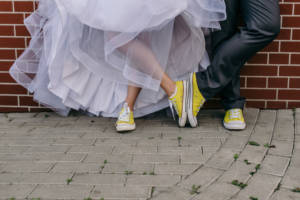Style and Substance: Your Practical Guide to Wedding Footwear

Finding stylish yet practical footwear for your nuptials does not have to be an impossible task if you keep in mind these suggestions.
Most individuals try to balance comfort, safety, and style when it comes to their work or casual attire. While your wedding may call for more upscale fashion, there’s no need to endure discomfort or pain. Yet many people end up doing that very thing, especially when it comes to their shoes. Without ample information or alternative suggestions, it’s easy to fall prey to traditions or habits. You can avoid this trap with tips for finding chic and practical footwear.
High Heeled Horrors and Obnoxious Oxfords
Podcaster Roman Mars revealed in a June 2014 Slate article that high heels were first worn by men. Their primary purpose was to help feet stay inside stirrups while riding horses. The fashion caught on with both genders until around the 18th century. It returned with popular pinup photos during World War II, then crossed over to the mainstream with much higher heights and thinner heel blocks. With these new iterations, style took priority over substance. Even so, StyleCraze points out the hazards of excessively high heeled shoes:
- Lower back pain
- Ankle sprains
- Foot and knee pain
- Sore calves
- Blisters and lacerations
- Restricted blood flow
- Hyperextended toes
WebMD points out other long-term risks such as bunions, heel spurs, hammertoes, corns, and callouses. In the short term, you’re likely more worried about foot pain and possible injuries after several hours on your feet. Besides being caused by heel height, some of these symptoms result from pointy, narrow toe boxes and super-stiff leather. Such traits are also found in dress shoes marketed for men, particularly lace-up Oxfords and loafers. Brides contributor Liz Susong shares her wedding day experience in which both she and her husband suffered pain caused by their shoes.
Essential Footwear Tips
Whether it’s hellacious heels or wicked wingtips, uncomfortable shoes can kill your enjoyment and enthusiasm. Man Repeller’s Harling Ross mentions the huge range of fancy options besides traditional heels and Oxfords that won’t kill your feet. WebMD, Prevention Magazine, and Brides writer Jenn Sinrich provide some suggestions for buying comfortable wedding footwear:
- Look for pairs with amply sized toe boxes. Rounded toes allow plenty of room, but you can also choose styles that slope to a point beyond your toes’ edges. Open-toed versions are another great option, but make sure the shoe’s vamp doesn’t constrict your feet.
- Steer clear of stilettoes, kitten heels, or heels higher than 2 inches. Chunkier heel styles such as block or wedges offer more support and stability, preventing ankle injuries and extra strain on the balls of your feet.
- Choose pairs with enough cushioning and arch support to absorb shock and minimize impacts on your feet.
- Consider adjustable styles. Those that buckle or lace up can accommodate any mild swelling of your feet throughout the day.
- Opt for softer materials. Stiff leather can constrict your feet and cause discomfort.
- If possible, have your feet measured and shop for footwear in the afternoon or evening.
Of course, all this assumes that you’ve already found your wedding attire. Wedding Wire Canada’s Alice Prendergast also offers some last-minute pointers. First, be sure to break them in before your wedding day. Second, avoid thin or spiked heels if you’re marrying outdoors. Finally, bring backup footwear with you to the venue. Regardless of whether you bought sensible shoes for the ceremony, your feet will thank you for changing into a comfortable pair before you hit the dance floor.
Shed Tears of Joy, Not of Pain
Your wedding will mark a significant milestone in your lifetime. Why sacrifice comfort for style when you can enjoy both in your footwear? Choose shoes that fit properly, provide plenty of comfort, and support your feet throughout the entire day. You deserve to be happy, and so do your feet.

